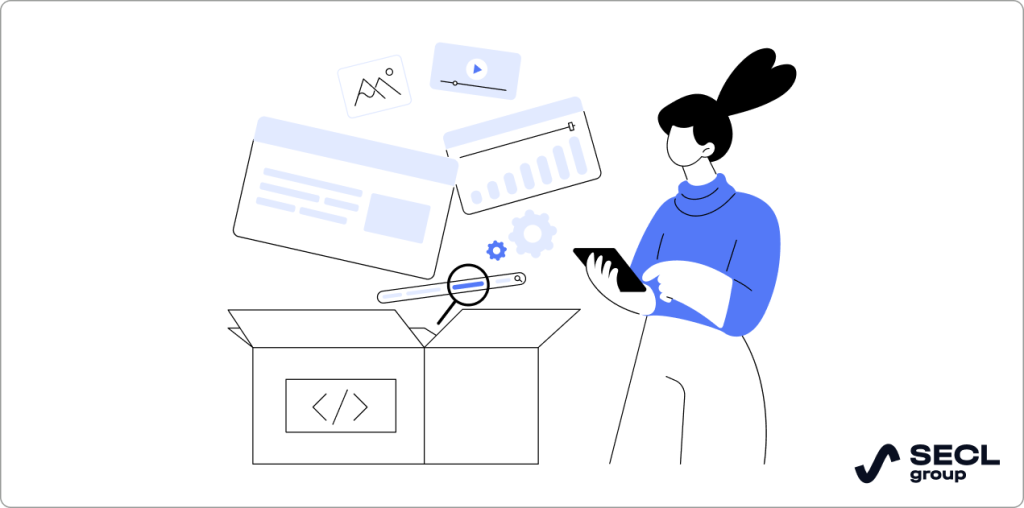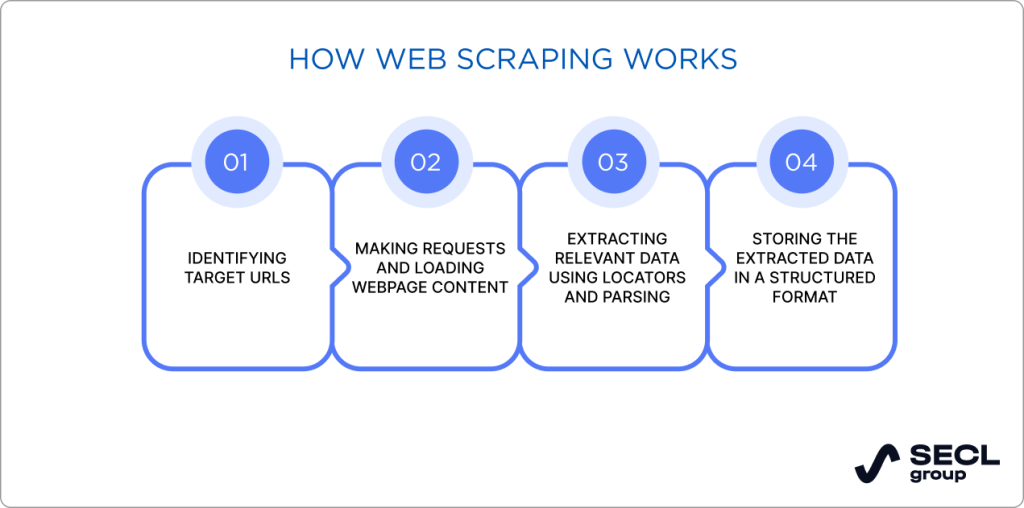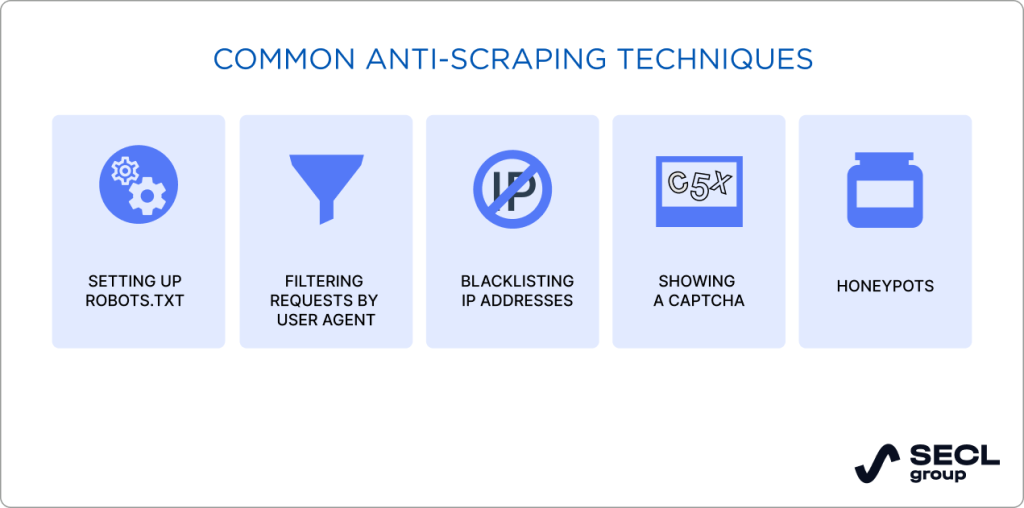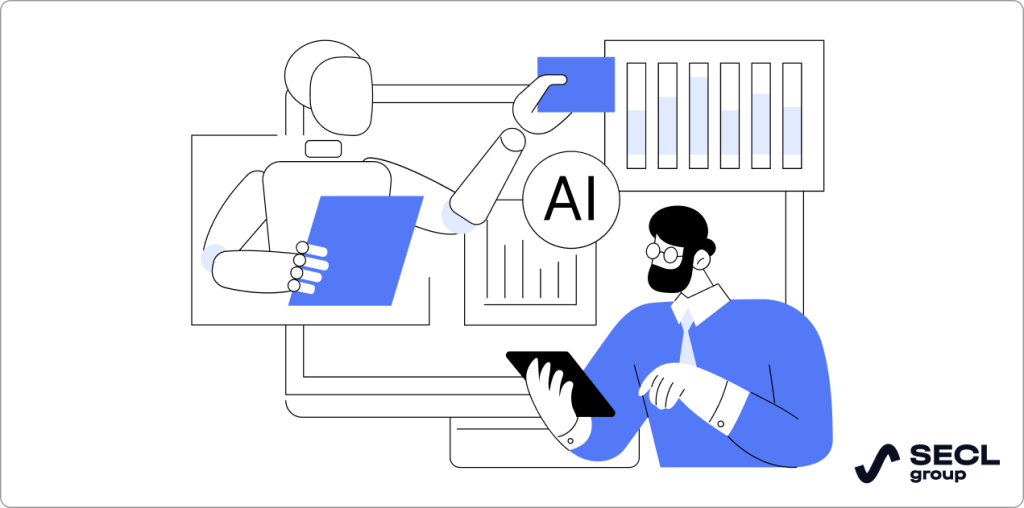- When is web scraping necessary?
- Our experience with web scraping
- Anti-scraping protection and how we worked around it
- The use of AI for data collection
- Traditional web scraping services vs AI-based
- The bottom line
Data scraping is an excellent opportunity when it comes to quickly filling your website, or at least a part of it, with content. A process of retrieving a variety of information from websites, data scraping often focuses on collecting specific pieces of data, including product information, contact details, etc. It can be performed on-demand, or occasionally in order to gather the most relevant information. As a rule, data scraping services are useful for tasks like price monitoring, content curation, sentiment analysis, or competitor analysis. Once complete, the results are delivered directly to the client’s website.
When is web scraping necessary?
You can use data scraping across various domains, with use cases of web scraping covering different industries, from e-commerce to travel, and staffing to finance. Price monitoring is one of the most common applications for website scraping. Generally, e-commerce stores and classified sites use dynamic pricing, where they can change prices numerous times per day, and understanding these price changes is essential in remaining competitive. Online sellers can utilise web data scraping to stay up-to-date with price shifts and adjust pricing strategies accordingly.

Market research is another popular use case. Web scraping services help businesses perform in-depth and relevant market and trends analysis. They can also monitor customer sentiment, market demands, and competitor approaches. Furthermore, businesses can maintain their reputation and look to improve products or services by scraping customer reviews and concerns. All of these valuable insights can help tailor marketing strategies and make more informed strategic decisions.
For real estate websites, web data scraping services are useful for consolidating information quickly. You can receive data and listings from multiple sources and then create content for your own website based on it. This way, you can provide more detailed information than your competitors and meet customer needs.
When it comes to the financial sector, web scraping helps analysts check for changes in stock and commodities pricing. This allows them to predict future changes and market responses, which can influence stock value and help investors make more profitable choices. With web scraping services, you can accumulate data from various sources and analyze critical economic indicators.
You can also use web scraping services for other purposes and in almost any domain imaginable. It can be applied in any case where you want to gather and utilize vast amounts of data without manual processing.

Our experience with web scraping
At SECL Group, we’ve used web scraping for several projects, and we’d like to share a few such cases to demonstrate our experience.
First of all, web scraping was very helpful when we built a real estate portal from scratch for one of our clients. They wanted us to develop a large platform for buying, selling, and renting real estate. However, they didn’t have the content to fill their website with.
The client asked us to develop data scraping tools for the three largest real estate websites. We obtained all of the listing details, including descriptions, contact information, images, etc. Just by posting these listings on the portal, the client received dozens of thousands of visitors per month. However, it’s important to note that Google didn’t have such strict regulations about content uniqueness at that time.
We also performed web scraping while developing a retail marketplace for re-selling goods made in China. It was an analog of Alibaba.com and we had to fill it with product information. For this project, we scraped data from Taobao.com, including product names, descriptions, seller contact information, etc. Then, we translated it from Chinese into the languages of the countries this marketplace worked in and used this data on the website. This way, the client’s website received traffic from search engines.
We also gathered information with web scraping tools for one of our Fintech projects. It was a platform for consolidating utility bills (gas, electricity, water, etc.) into a single system and paying for them within it. This was a Singapore-based startup that operated in various countries in Asia.
We scraped data from different government websites. Sometimes, the process was challenging due to the use of outdated technologies on these websites, for instance, many government websites in India used such legacy technologies. Despite this we managed to obtain 90% of the information we needed, whilst the remaining 10% required too much time to scrape. The client decided it would be unwise to pursue the remaining 10% at that stage.
Anti-scraping protection and how we worked around it
It’s also important to mention how we bypassed different levels of anti-scraping protection on different websites. First, you need to keep in mind that the complexity of such protections depends on the size and popularity of the site. For instance, small websites are less likely to employ sophisticated multi-level protection than giants like Amazon or Taobao. In the end, we needed a couple of months to bypass anti-scraping protection before completing the task.

Above all, any unhuman-like interaction with a website causes suspicion. This pertains to crawling pages too fast, a high number of requests per user, etc. Generally, bots crawl pages at a very high speed or make lots of interactions, such as a human could never do in a short time.
Some websites also utilise dynamic content rendering to load their content with JS or AJAX. This means that the data is not available in the HTML page source code. Instead, it is the browser or the server that generates it on the go. This makes it more challenging for scraping to collect data. They need to execute the JavaScript code or make a higher volume of requests to obtain the full information from pages.
Also, the website owners may change the names of the fields in the code so that they don’t meet the requirements and therefore don’t get scraped. This way, scrapers don’t understand where the needed information is, while nothing changes for an ordinary user. Sometimes, websites use randomised modifications to interrupt the bot workflow in different ways. That’s why you need to constantly improve and support your scripts, which we work on across all of our projects. You also have to constantly review the data received from the website and load them only when they are correct.
Luckily, almost all modern scraping solutions have features designed to avoid getting blocked or to get around the protection techniques we have described above. Here are the typical methods of bypassing anti-scraping tools that we use in our projects:
- slowing down the script so that it spends more time on one page;
- using CAPTCHA-solving techniques for automated solving challenges;
- utilising proxies from different regions to avoid geolocation-based blocking;
- using a pool of IP addresses to distribute requests and prevent IP blocking;
- Adding randomised requests to mimic human behaviour.
It’s also important to analyse the websites you plan to retrieve data from and learn about the types of anti-scraping protection used. The larger and more complex the websites are, the more sophisticated scraping solution you need in order to obtain data successfully. You need to constantly monitor for new protection methods and maintain a high quality of retrieved information.
Generally, web scraping solutions are built with Python. This programming language is preferred for these tasks as its high-quality libraries allow for fast receipt of data. Sometimes, certain JS libraries are also used to bypass protections. We won’t dive deeply into the technical aspects of a web scraping service in our article. However, you can reach out to us if you want help scraping large volumes of data.
If you are looking to build a scraping solution with Python, we can help you
Get in touch with our team to discuss the details.
The use of AI for data collection
Traditional web scraping is extremely advantageous. Without it, we would have to perform a time-consuming process of receiving data manually. However, it still comes with some limitations, and AI and ML algorithms are changing the data scraping process, making it more efficient and scalable.

AI-based data collection makes the scraping process much more efficient. Generally, AI already knows the information to be gathered and can generate it very quickly. In other cases, you can write a prompt for an AI-based tool to find and group the required information. Generally, the first option is more common and can be easily added through an API integration with an AI that has a vast database.
Using AI for web scraping is an alternative approach that has its many advantages. AI-powered tools don’t scrape data from a certain website, rather they gather them from all over the internet and present them in a unified format. For instance, you can collect product characteristics or reviews and translate them into a different language for comparative analysis.
We use AI in web data scraping services for a travel startup we work with, who have a comprehensive platform for trip planning. The platform needs to be very informative as it covers various aspects of travel data and planning, from prices to weather and destinations. On this project, AI-powered website scraping helps us receive accurate information on such vast amounts of data.
Recently, we’ve worked on developing tasks that monitor hotel and apartment rent prices, air and water temperature each month, and find safe areas to stay in a city or country. For example, we retrieve data from Booking.com for monitoring hotel reservation prices, and AirBnb.com for apartments. We also scrape other websites, such as Vrbo or Tripadvisor rentals for countries where the previous two services are not so popular. And this all pertains to only one aspect of the travel website we work on.
As a result, AI helped provide reliable details on average monthly water and air temperature in different locations. This was extremely cost-effective as the integration took us a few days instead of months.
However, AI-based web scraping services couldn’t replace traditional methods in some cases. To illustrate, generating average accommodation prices was challenging as AI provided inconsistent results. Overall, we decided to use AI-powered solutions for more than a dozen tasks on this project. This helped us save many thousands of dollars. We ended up using both traditional and AI-based solutions for different tasks.
Selecting the best AI-based solution is also important. There are different types of AI, each having its specifics, pros and cons. You can choose between ChatGPT, Gemini, Jasper, QuillBot, and less popular tools. You also require detailed prompts and an experienced AI operator who knows how to write prompts to receive accurate data.
Traditional web scraping services vs AI-based
When it comes to choosing optimal web scraping methods, everything depends highly on the project in question. Both methods have their pros, cons, and use cases of web scraping. Let’s have a closer look at them in this part of the article.
On the one hand, conventional data scraping has an easy setup for simple websites and works quickly and effectively for static and well-structured sites. However, it requires more maintenance where there are structural changes and has a very limited understanding of the information context or meaning.
On the other hand, AI-powered web scraping is more resilient to changes in website structure, minimizes manual intervention and maintenance with self-learning capabilities, and can understand information based on context. Yet, you may need specialists with advanced knowledge of machine learning and NLP to retrieve data efficiently and without possible errors.
As a rule, AI-based APIs provide paid services. Since we generate data using them only once, it remains an affordable option. In some cases, you’ll need just a few hundred dollars to retrieve the necessary information. Building a scraping tool from scratch, updating, and supporting it will incur a much more substantial investment. Maintaining an AI API is also more straightforward as you only need to change the prompt and the database spaces to store the data in.
When selecting suitable web scraping services, you need to consult with an experienced team who will help you decide on the best tech stack, find ways to bypass anti-bot protection, and define the most cost-effective solutions for your needs.
The bottom line
Nowadays, businesses are much less likely to succeed without having information from a wide range of sources. Web scraping helps gather vast amounts of data for further use or analysis. It has a wide range of applications and sometimes it is the only way to retrieve so much information so quickly. We have used it for our e-commerce projects, mainly marketplaces and enterprise-grade systems.
As an alternative to traditional scraping, AI-based tools help you save time and money on this process. However, for now, AI can’t replace this process completely, although it’s getting closer with each passing moment.
If you are looking for experienced web scraping service providers who also implement AI-powered tools, feel free to reach out to us.